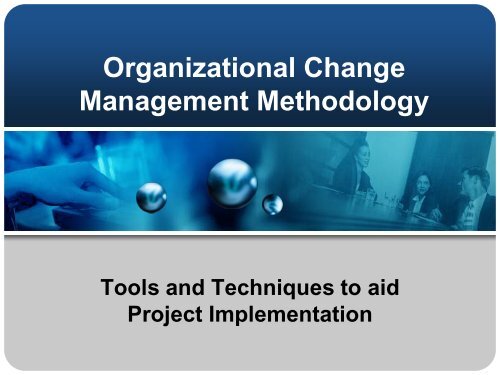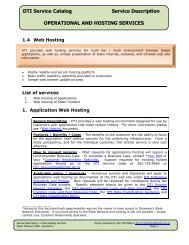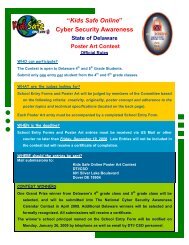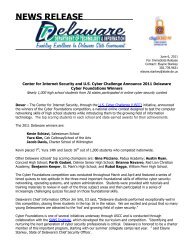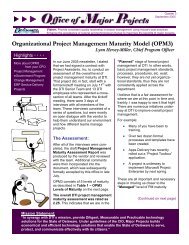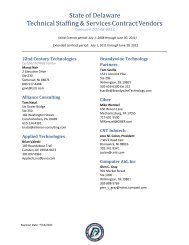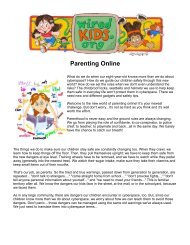Organizational Change Management Methodology
Organizational Change Management Methodology
Organizational Change Management Methodology
Create successful ePaper yourself
Turn your PDF publications into a flip-book with our unique Google optimized e-Paper software.
<strong>Organizational</strong> <strong>Change</strong><br />
<strong>Management</strong> <strong>Methodology</strong><br />
Tools and Techniques to aid<br />
Project Implementation
Today’s Objectives<br />
• Discuss the <strong>Organizational</strong> <strong>Change</strong><br />
<strong>Management</strong> team and explore<br />
ways <strong>Organizational</strong> <strong>Change</strong><br />
<strong>Management</strong> can work with Apps<br />
Delivery<br />
• Cover <strong>Organizational</strong> <strong>Change</strong><br />
<strong>Management</strong> tools<br />
• Explain <strong>Organizational</strong> <strong>Change</strong><br />
<strong>Management</strong> metrics
Implementation Success Factors<br />
Source<br />
Understanding PeopleSoft 8<br />
Lynn Anderson, Cap Gemini Ernst & Young
Process Integration<br />
Project <strong>Management</strong><br />
Project Initiation<br />
Project Planning<br />
Project Executing<br />
Organization <strong>Change</strong><br />
<strong>Management</strong><br />
Preparing for <strong>Change</strong><br />
Managing <strong>Change</strong>-Planning<br />
Project Controlling<br />
Managing <strong>Change</strong>-Execute<br />
Project Closing<br />
Closing/Monitoring <strong>Change</strong>
Selecting a <strong>Change</strong> Strategy<br />
• Degree of resistance<br />
• Target population<br />
• The stakes<br />
• Time frame<br />
• Expertise<br />
• Dependency
OCM Materials and Tools<br />
• <strong>Change</strong> <strong>Management</strong> <strong>Organizational</strong><br />
Assessment<br />
• Tailoring Spreadsheet<br />
• Comprehensive CM Plan<br />
• Functional Impacts Spreadsheet<br />
• Readiness Activities/Master Readiness<br />
Tracking Spreadsheet<br />
• Readiness Checklists<br />
• Executive Reports<br />
• <strong>Organizational</strong> <strong>Change</strong> <strong>Management</strong> metrics<br />
6
<strong>Organizational</strong> Readiness Assessment<br />
• <strong>Change</strong> <strong>Management</strong> completes<br />
the <strong>Organizational</strong> Readiness<br />
Assessment by meeting with the<br />
– Project Manager<br />
– Project Sponsor<br />
– Project Subject Matter Expert
Assessment Objectives<br />
• Scope of change<br />
• Impacted groups<br />
• Number of impacted employees<br />
• Type and amount of change<br />
• Timeframe for the project<br />
• <strong>Change</strong> culture<br />
• Organization value structure<br />
• Organization change capacity<br />
• Organization leadership style and power distribution<br />
• Organization past change history<br />
• Organization pre-disposition towards change<br />
• Sponsor model
<strong>Organizational</strong> Readiness Assessment
Risk Determination Table<br />
105<br />
Small <strong>Change</strong><br />
They Do Not<br />
Like Us<br />
Medium Risk<br />
Big change<br />
They Do Not<br />
Like High Us Risk<br />
<strong>Organizational</strong><br />
Traits<br />
50<br />
21<br />
Threshold<br />
Small<br />
<strong>Change</strong> Low Risk<br />
They Like Us<br />
Thr<br />
es<br />
hol<br />
d<br />
Big <strong>Change</strong><br />
Medium Risk<br />
They Like Us<br />
17 34<br />
80<br />
<strong>Change</strong> Traits<br />
10
OCM Tailoring Process<br />
• The purpose of the OCM Tailoring<br />
process is to customize the OCM<br />
strategy and deliverables to the<br />
size and complexity of the project<br />
• Next step after completing the<br />
<strong>Organizational</strong> Readiness<br />
Assessment
OCM Tailoring Spreadsheet
Comprehensive OCM Plan<br />
Derived from the Assessment and OCM<br />
tailoring process<br />
Provides guidance towards:<br />
• Sponsor Roadmap<br />
• Communication Plan<br />
• Readiness Strategy<br />
• Training<br />
• Coaching<br />
• Resistance <strong>Management</strong>
All Project<br />
Teams<br />
I<br />
N<br />
P<br />
U<br />
T<br />
DTI Readiness<br />
<strong>Methodology</strong><br />
Functional Impacts<br />
Documentation<br />
Master Readiness Tracking<br />
Spreadsheet<br />
Readiness<br />
Checklist<br />
Functional<br />
Impacts<br />
End Users<br />
Successful System Implementation<br />
14
Functional Impacts<br />
• The result of an initiative<br />
– The “as is” state<br />
– The “to be” state<br />
– Begins to map between the two<br />
• Functional impacts document<br />
project decisions that impact endusers<br />
15
Examples of Functional Impacts<br />
• New Technology Required<br />
• The way a task gets done is different<br />
• The task that a person does is different<br />
(new roles)<br />
• Timelines – When the task must be<br />
done is different<br />
• Integration – Who the person interacts<br />
has changes<br />
• New Information is available<br />
16
Categories<br />
• Process changes with overall business<br />
impact<br />
• New roles for accomplishing existing task(s)<br />
• New functionality for accomplishing an<br />
existing task(s)<br />
• Timeline change(s) for accomplishing<br />
existing task(s)<br />
• Different integration or interaction with<br />
people<br />
• New information available (online or report)<br />
• New technology required<br />
17
Analysis<br />
• Organization process flows<br />
• Organization charts<br />
• Forms currently used to accomplish work<br />
• Requirements documentation<br />
• Actual items used to complete the task(s) at hand<br />
– Computers<br />
– Projectors<br />
– Window envelopes – e.g. where positioning of<br />
window for address is critical for continued use<br />
– Office equipment<br />
– Policies and procedures<br />
18
Functional Impacts<br />
19
OCM Uses of Functional Impacts<br />
1. Feed the Master Readiness<br />
Tracking Spreadsheet<br />
2. Develop checklists<br />
3. Track, measure, and report<br />
readiness<br />
4. Communicate upcoming changes<br />
to end-users<br />
20
Readiness Activities<br />
• Specific tasks that each organization will<br />
need to complete prior to implementation<br />
• The identified activities are listed on the<br />
Master Readiness Tracking Spreadsheet in<br />
approximate chronological order<br />
• The <strong>Organizational</strong> <strong>Change</strong> <strong>Management</strong><br />
Specialist will:<br />
– Communicate these activities and dates<br />
– Facilitate the activities by providing<br />
information and coaching to the<br />
organizations<br />
21
Master Readiness Tracking Spreadsheet<br />
Comprehensive list of all activities<br />
that must take place during the<br />
course of a project implementation<br />
to ensure end-user readiness.<br />
22
Sources of Data<br />
• Functional Impacts spreadsheet<br />
• Previous project implementations<br />
• Project meetings<br />
• Key end-user meetings<br />
• Technical requirements of<br />
associated software<br />
23
The Spreadsheet<br />
• Updated throughout the course of a project<br />
• Items on this list are given a target date<br />
• The <strong>Organizational</strong> <strong>Change</strong> <strong>Management</strong><br />
Specialist lists and tracks the activities<br />
• This effort identifies specific dates by which<br />
these activities must be completed Progress<br />
against the activities is tracked and reported to<br />
the executive sponsors and organization heads<br />
as an indicator of readiness<br />
• Readiness activities are identified and then<br />
documented on a Master Readiness Spreadsheet.<br />
24
Master Readiness Tracking Spreadsheet<br />
25
Readiness Checklists<br />
• Checklists are typically sent out on<br />
a monthly basis<br />
• Ensure end-user and organization<br />
readiness for project<br />
implementation<br />
• Items for this list are taken from<br />
the Master Readiness Tracking<br />
Spreadsheet<br />
26
Purpose<br />
• Provide a mechanism for tracking and<br />
identifying whether organizations are<br />
prepared or not for implementation<br />
• The <strong>Organizational</strong> <strong>Change</strong><br />
<strong>Management</strong> Specialist monitors<br />
progress of each assigned organization<br />
• Project status will be reported to<br />
project management and the Executive<br />
Sponsors<br />
27
Readiness Checklists<br />
28
Executive Reports<br />
• A more condensed version of the Master<br />
Readiness Tracking Spreadsheet<br />
• Updated as each checklist is received<br />
• Used to report progress to the Executive<br />
Steering Committee, Organization<br />
Executives, Project Manager(s), Business<br />
Owners and the Director of Major Projects<br />
• Project management may identify<br />
interventions.<br />
29
Executive Sponsor Reporting<br />
30
End-User Identification & Skills Inventory<br />
• End-User Inventory<br />
– End-User Identification<br />
– Manager/Supervisor Identification<br />
– Specify Key-End User<br />
– Skills Gap Analysis<br />
– Identify IT Support Personnel and<br />
Technical Specifications<br />
31
End-user Inventory<br />
1 st<br />
End-user Identification and Demographic<br />
Information<br />
2nd<br />
Skills Inventory<br />
3rd<br />
IT<br />
sppt.<br />
32
Communication Tracking Spreadsheet<br />
• Used to gather<br />
<strong>Organizational</strong><br />
<strong>Change</strong> <strong>Management</strong><br />
communication<br />
metrics<br />
• Also used as<br />
communication plan<br />
• Takes Project<br />
Schedule into<br />
consideration<br />
• Media Used<br />
• Communication Title<br />
• <strong>Organizational</strong> <strong>Change</strong><br />
<strong>Management</strong><br />
communication campaign<br />
• Date sent<br />
• Who initiated<br />
communication<br />
• From/To<br />
• Nature of communication<br />
• Question Category<br />
• Follow up needed<br />
and follow up type<br />
• Ties to EPM schedule<br />
• Days in Review<br />
• Comments<br />
33
Information Sheets<br />
Awareness Info Sheet<br />
Coaching Info Sheet<br />
34
Resistance<br />
Resistance can be defined as:<br />
• Withstanding, striving against, or<br />
opposing<br />
• Withstanding the action or effect<br />
of<br />
• Acting or making efforts in<br />
opposition<br />
35
Reasons for Resistance<br />
Lack of awareness<br />
<strong>Organizational</strong><br />
Restructuring<br />
Lack of training/<br />
expertise<br />
Comfort with<br />
status quo<br />
Too little time<br />
Communication<br />
Sponsor Involvement<br />
Training<br />
Communication,<br />
sponsor involvement<br />
Coaching<br />
Sponsor involvement<br />
36
Behaviors we need to Discourage<br />
(end-users)<br />
• Talk one way in public<br />
• Stop performing their current<br />
responsibilities<br />
• Ignore or block progress or<br />
sabotage the process<br />
• Avoid using the new work<br />
processes or tools<br />
• Talk negatively<br />
• Take advantage of problems<br />
37
Behaviors we need to Discourage<br />
(managers/supervisors)<br />
• Talk badly about project<br />
• Meet with staff and minimize the<br />
change<br />
• Prevent staff from participation<br />
• Refuse necessary resources<br />
38
<strong>Organizational</strong> <strong>Change</strong> <strong>Management</strong><br />
Resistance Assessment<br />
39
Strategies for Resistance<br />
• Enhance Communication<br />
• Work with sponsors<br />
• Work with managers/supervisors<br />
• Develop the Key End User<br />
community<br />
• Work with the PM<br />
• Work with HR<br />
40
Sponsor Roadmap<br />
• Sponsors need to<br />
– Show active and visible support<br />
– Ensure project is a priority<br />
– Communicate frequently<br />
– Communicate understanding<br />
– Provide resources<br />
– Gain buy-in<br />
41
<strong>Organizational</strong> <strong>Change</strong> <strong>Management</strong><br />
Sponsor Assessment<br />
42
Sponsor Roadmap<br />
• Support<br />
• Decision-making<br />
• Authority<br />
• Questioning<br />
• Communication<br />
• Resources<br />
43
Training Plan Strategy<br />
• Identify different audiences<br />
who require training<br />
• Conduct training needs<br />
assessment and skill gap<br />
analysis<br />
• Document requirements for<br />
the training team<br />
– Training development<br />
schedule<br />
44
Coaching Plan<br />
• Customized Coaching Plan<br />
• Prepare managers and<br />
supervisors to coach their<br />
employees through the change<br />
45
Transition<br />
Develop<br />
• Transition plan<br />
Train<br />
• Organization resources<br />
46
Help<br />
• Service Desk Info sheet. Includes<br />
information about:<br />
– The system<br />
– The go-live dates<br />
– Expected problems<br />
– Who to contact for level two support<br />
• Use of labs<br />
• Use of application coaches<br />
47
Knowledge Transfer<br />
• Sometimes the production support team<br />
does not possess the skills to support the<br />
application post-implementation.<br />
– Must identify this gap and develop knowledge<br />
transfer/staff development plans.<br />
– Plans are used to identify knowledge transfer<br />
channels, staff development activities, and<br />
knowledge transfer timeline<br />
– Identification of categories of knowledge and<br />
skills needed to support knowledge transfer<br />
objectives.<br />
– Identification of how the knowledge transfer and<br />
staff development will be tracked<br />
48
Knowledge Transfer<br />
• Skills Development Profile<br />
– Used to plan and document each<br />
team member’s knowledge and<br />
skills<br />
– Identification of responsibilities for<br />
staff development/knowledge<br />
transfer by aligning coach/mentor<br />
with staff<br />
• Knowledge transfer timeline to<br />
meet objectives.<br />
49
Analyzing/Transitioning <strong>Change</strong><br />
• Transition<br />
– Knowledge Transfer Plan<br />
(Transfer ownership to Project Owner)<br />
• Communication<br />
• Focus Group Meetings<br />
• Key End-User Meetings<br />
• Manager/Supervisor Meetings<br />
• On-going <strong>Change</strong> <strong>Management</strong><br />
responsibilities<br />
51
Analyzing/Transitioning <strong>Change</strong><br />
• Collecting, Reporting, and Analyzing Feedback<br />
– Compliance Audit<br />
– Post-Implementation Review Process<br />
• Transitioning to the Business Owner<br />
• Celebrate!<br />
– Milestones/successes<br />
– Implementation success<br />
52
Monitoring <strong>Change</strong><br />
Survey End Users<br />
• Post implementation<br />
– Three months<br />
– Six months<br />
– One year<br />
• Complete control book<br />
– Lessons learned<br />
– Survey results<br />
– Training and meeting evaluations<br />
– Help desk call analysis<br />
– Checklist statistics<br />
53
<strong>Organizational</strong> <strong>Change</strong><br />
<strong>Management</strong> Metrics
Why Metrics?<br />
• The US Congress has mandated<br />
legislation through the Government<br />
Performance and Results Act (GPRA)<br />
of 1993.<br />
• The key metric for government<br />
performance is mission<br />
effectiveness.<br />
55
Why Metrics?<br />
• Typically these categories:<br />
1. Strategic needs metrics<br />
2. Mission effectiveness metrics<br />
3. Operational efficiency metrics<br />
• Selected metrics should answer<br />
the question, "How do you know<br />
how well the organization is<br />
doing?"<br />
56
Questions to ask when establishing metrics:<br />
1. Where is the organization headed…what<br />
is the vision?<br />
2. What does senior management expect to<br />
get from implementing metrics collection<br />
and reporting<br />
3. What are we doing? How well are we<br />
doing it? How can we demonstrate to<br />
others how well we are doing it?<br />
4. How efficient are our generic business<br />
processes in comparison with the best<br />
practices?<br />
57
Metrics Guide Decisions<br />
• What do we want (need) to expand.<br />
– Long term hiring decisions<br />
– Future training within the organization<br />
– Construction of additional facilities, or<br />
architectures to support the enterprise<br />
• What we want to maintain.<br />
• What we want to reduce.<br />
• Routine office processes and<br />
business practices<br />
58
Metrics are about<br />
• Transforming policy into action<br />
• Measuring performance<br />
• Motivation<br />
• Refining processes by monitoring<br />
outcomes<br />
• <strong>Organizational</strong> alignment<br />
• Determining processes in need of<br />
improvement<br />
59
<strong>Organizational</strong> <strong>Change</strong> <strong>Management</strong><br />
Metrics<br />
• Sponsorship management<br />
• Communication planning<br />
• Readiness<br />
• Training<br />
• Coaching activities<br />
• Resistance management<br />
• Monitoring and closing<br />
60
Tie to DTI’s Organization Goals<br />
• Enhanced project management<br />
• IT Availability and Reliability<br />
• Workforce Excellence<br />
• Enhanced Customer Service<br />
• Collaborative Solutions<br />
61
<strong>Organizational</strong> <strong>Change</strong> <strong>Management</strong><br />
Metrics Levels<br />
• Enterprise level<br />
• Individual <strong>Organizational</strong> <strong>Change</strong><br />
<strong>Management</strong> Specialist<br />
• Specific project level<br />
62
Enterprise Metrics<br />
• <strong>Organizational</strong> <strong>Change</strong> <strong>Management</strong><br />
adherence to Best Practices<br />
• On-time Readiness task completion<br />
• Customer satisfaction<br />
• Number of projects the team is on.<br />
– The percentage of these projects completed ontime/under-budget.<br />
• How effective the team is overall<br />
• The percentage of our tools that are used.<br />
– Which tools are used most often,<br />
– which tools are used the least.<br />
63
Enterprise Metrics<br />
• Communication efforts<br />
– What type of feedback have we received?<br />
– What are the most common questions we<br />
are asked?<br />
– What type of communication is used<br />
most often, etc.<br />
• What is the most common category of<br />
problem encountered upon<br />
implantation?<br />
• Training Metrics<br />
64
Additional Metrics<br />
• How effective is each <strong>Organizational</strong><br />
<strong>Change</strong> <strong>Management</strong> specialist<br />
• Communication efforts<br />
– What type of feedback have we received?<br />
– What are the most common questions we<br />
are asked?<br />
– What type of communication is used<br />
most often, etc.<br />
65
<strong>Organizational</strong> <strong>Change</strong> <strong>Management</strong><br />
Tools<br />
• Metrics gained from the<br />
<strong>Organizational</strong> Readiness Assessment<br />
include:<br />
– Number of projects in risk quadrant<br />
– Number of projects projected to require<br />
specific segments of the <strong>Organizational</strong><br />
<strong>Change</strong> <strong>Management</strong> plan<br />
– Which tools were actually used during<br />
the project<br />
– Stakeholder analysis<br />
66
Communication Metrics<br />
• Media used<br />
• Communication Title<br />
• Communication Campaign<br />
• Date Sent<br />
• Communication Initiated By<br />
• From / To<br />
• Nature of the Communication<br />
• Question Category<br />
• Follow-up needed and Follow-up type<br />
• EPM Scheduled Release and Actual Release Date<br />
• Days in Review<br />
67
Customer Satisfaction Surveys<br />
• Understanding-Awareness Survey<br />
• Impact-Desires Survey<br />
• Training Survey<br />
• Coaching Survey<br />
• Post Implementation Survey<br />
• Evaluation Survey<br />
68
Readiness Metrics<br />
• Readiness involves<br />
– Analyzing an organization to<br />
identify the current state and the<br />
future desired state<br />
– Identifying what is required to move<br />
from one state to the other<br />
69
Readiness – End User Spreadsheet<br />
• End-User Role Defined<br />
• End-Users assigned to system<br />
roles<br />
• Critical<br />
Managers/supervisors/Leaders to<br />
participate in <strong>Change</strong> Leadership<br />
Training<br />
• End-Users who should attend<br />
Role <strong>Change</strong> Workshops<br />
70
Readiness<br />
Functional Impacts Spreadsheet<br />
• Type of change<br />
• The method to address the<br />
changes<br />
• Category of the change<br />
71
Readiness<br />
Master Readiness Tracking Spreadsheet<br />
• Completed tasks<br />
– By due date<br />
– Consistently late<br />
– Not at all<br />
• Which <strong>Organizational</strong> <strong>Change</strong> <strong>Management</strong> specialists<br />
have a greater success getting items completed by due<br />
date<br />
• What percentage of organizations have completed<br />
specific tasks<br />
• What percentage of tasks are left overall<br />
• What percentage of tasks are related to<br />
– Hardware / Software<br />
– Business Process / Forms / Policies & Procedures<br />
– Training<br />
– Conversion<br />
– Security<br />
• Employee Roles and Responsibilities<br />
72
Training Metrics<br />
• <strong>Organizational</strong> <strong>Change</strong> <strong>Management</strong> is<br />
involved in developing the training strategy,<br />
and oversight of the training effort.<br />
• All training that is provided by the project<br />
will be evaluated.<br />
• Additionally, the <strong>Organizational</strong> <strong>Change</strong><br />
<strong>Management</strong> team will track<br />
– Number of attendees,<br />
– Time or day of training preferences<br />
– Training venue preferences<br />
– Instructor preferences<br />
73
Sponsor Metrics<br />
• Number of projects with sponsors<br />
• Average sponsor power rankings<br />
• Sponsor Commitment index<br />
• Sponsor Coalition index<br />
• Sponsor Communication index<br />
• Sponsor as Manager index<br />
74
Sponsor Commitment<br />
How committed the sponsor is to the project<br />
How influential they are.<br />
Calculated using questions from sponsor<br />
assessment<br />
Question # 2 (sponsor is in a powerful position<br />
within the organization with access to higher<br />
management, or there is no higher<br />
management than them )<br />
Question # 4 (Sponsor has the ability to use<br />
personal power or status to overcome<br />
problems and is willing to demonstrate public<br />
support) on the sponsor assessment.<br />
75
Sponsor Coalition<br />
• Indicates the sponsor’s ability to influence<br />
others and create a coalition of individuals<br />
who are prepared to support the project.<br />
• Calculated using questions from sponsor<br />
assessment<br />
– Question # 4 (Sponsor has the ability to use<br />
personal power or status to overcome problems<br />
and is willing to demonstrate public support)<br />
– Question #5 (Sponsor has special relationships<br />
inside and outside of the organization which will<br />
be helpful in gaining acceptance of the change)<br />
76
Sponsor Communication<br />
• Indicates the sponsor’s ability to clearly and<br />
succinctly communicate the project.<br />
• Calculated using questions from Sponsor<br />
Assessment<br />
• Question # 6 (Sponsor Has in the past,<br />
publically pinpointed behaviors that must<br />
change.)<br />
• Question# 7 (Sponsor has demonstrated<br />
strong communication skills in the past,<br />
providing clear, concise, and understandable<br />
messages during previous projects.)<br />
77
Sponsor as Manager<br />
• Indicates how successful the sponsor will be in<br />
managing the portfolio of projects to assist with<br />
successful completion of the project.<br />
• Calculated using questions from Sponsor<br />
Assessment.<br />
– Question #8 (Sponsor will commit the resources<br />
necessary to achieve the objectives of this<br />
change)<br />
– Question # 9 (Sponsor has prioritized activities<br />
and resources in the organization to reflect the<br />
importance of this project),<br />
– Question #10 (Sponsor has established<br />
mechanisms to gather data to monitor the<br />
progress of the project).<br />
78
Coaching Metrics<br />
• Manager/supervisor efforts to explaining<br />
the project to subordinates.<br />
• Manger/supervisor support for the project.<br />
• Manager/supervisor to aid staff in preparing<br />
for the project and completion of readiness<br />
efforts.<br />
• Manager/supervisor efforts to collect<br />
feedback from staff.<br />
• Manager/supervisor support of the project<br />
through re-prioritization of work efforts.<br />
79
Resistance Metrics<br />
• Awareness Resistance<br />
• Org Restructuring Resistance<br />
• Status Quo Resistance<br />
80
Calculating Awareness Resistance<br />
• Indicates the project is encountering<br />
resistance because individuals involved do<br />
not have a clear understanding of what to<br />
expect.<br />
• Calculated using the Resistance Assessment<br />
– Question # 1 (How well defined is the business<br />
benefit of the project?),<br />
– Question #2 (How well defined is the scope of the<br />
project?)<br />
– Question #6 (The business requirements are…)<br />
from the resistance assessment worksheet.<br />
81
Calculating Status Quo Resistance<br />
• Indicates the resistance is probably<br />
based upon fondness for the status<br />
quo<br />
• Calculated using the Resistance<br />
<strong>Management</strong> Assessment<br />
– Question #4 (Managers and supervisors<br />
(critical managers) can be described as…)<br />
– Question #5 (The end-user commitment<br />
level is…).<br />
82
Calculating Org Restructuring Resistance<br />
• Indicates resistance based upon<br />
real or feared organizational<br />
restructuring<br />
• Calculation is based on questions<br />
from the Resistance Assessment<br />
– Question #7 (Business processes,<br />
procedures, policies require…)<br />
– Question # 8 (<strong>Change</strong>s to the<br />
organizational structure require…)<br />
83
Implementation Success Factors<br />
Source<br />
Understanding PeopleSoft 8<br />
Lynn Anderson, Cap Gemini Ernst & Young
Questions?


